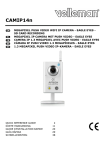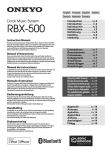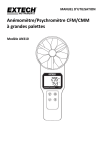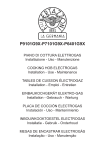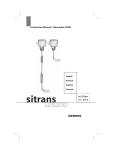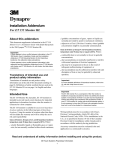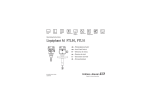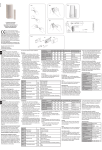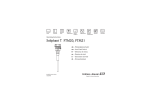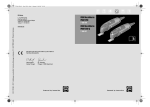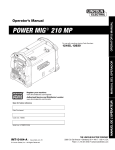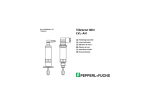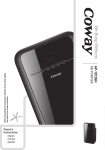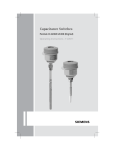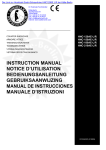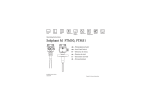Download POINTEK VLS 200 - Service, Support
Transcript
Instruction Manual March 2002 POINTEK VLS 200 Gebruiksaanwijzing Nederlands Manuel d’Instructions Français Manual de Instrucciones Español Betriebsanleitung Deutsch Instruction Manual English POINTEK VLS 200 Safety Guidelines Warning notices must be observed to ensure personal safety as well as that of others, and to protect the product and the connected equipment. These warning notices are accompanied by a clarification of the level of caution to be observed. Qualified Personnel This device/system may only be set up and operated in conjunction with this manual. Qualified personnel are only authorized to install and operate this equipment in accordance with established safety practices and standards. Warning: This product can only function properly and safely if it is correctly transported, stored, installed, set up, operated, and maintained. Note: Always use product in accordance with specifications. Copyright Siemens Milltronics Process Instruments Inc. 2002. All Rights Reserved Disclaimer of Liability This document is available in bound version and in electronic version. We encourage users to purchase authorized bound manuals, or to view electronic versions as designed and authored by Siemens Milltronics Process Instruments Inc. Siemens Milltronics Process Instruments Inc. will not be responsible for the contents of partial or whole reproductions of either bound or electronic versions. While we have verified the contents of this manual for agreement with the instrumentation described, variations remain possible. Thus we cannot guarantee full agreement. The contents of this manual are regularly reviewed and corrections are included in subsequent editions. We welcome all suggestions for improvement. Technical data subject to change. MILLTRONICS®is a registered trademark of Siemens Milltronics Process Instruments Inc. Contact SMPI Technical Publications at the following address: Technical Publications Siemens Milltronics Process Instruments Inc. 1954 Technology Drive, P.O. Box 4225 Peterborough, Ontario, Canada, K9J 7B1 Email: [email protected] For the library of SMPI instruction manuals, visit our Web site: www.milltronics.com © Siemens Milltronics Process Instruments Inc. 2002 VLS 200 Introduction The Pointek VLS 200 is a vibrating level switch that detects high or low levels of dry bulk solids in bins, silos, or hoppers. The VLS 200 provides a contact output for levels of products such as lime, styrofoam, flour, and plastic granules. With a compact design, the VLS 200 can be top- or side-mounted. The vibrating fork design of the VLS 200 provides constant self-cleaning to the tines. Product Features • • • • • High resistance to mechanical forces Strong vibration resistance to high bulk material loads Rotatable enclosure Stainless steel 1½” NPT or R 1½" DIN 2999 (tapered) threaded connection Suitable for low density material (20 g/l or 1.2 lb/ft3) Product Applications • • Lime, styrofoam, flour, plastic granules Low or high bulk density materials Principle of Operation A signal from the electronic circuit excites a crystal in the probe causing the fork to vibrate at a frequency of 125 Hz. If the fork is covered by material, the change in vibration is detected by electronic circuitry which causes the relay to change state after a one second delay. When the material no longer reaches the tines, full vibration resumes and the relay reverts to its normal condition. 7ML19981FT61 Pointek VLS 200 – INSTRUCTION MANUAL Page 1 mmmmm • Installation, maintenance and commissioning must be performed by qualified technical personnel. The VLS 200 must be used only in the manner outlined in this instruction manual. English Notes • English mmmmm Specifications Note: Siemens Milltronics makes every attempt to ensure the accuracy of these specifications but reserves the right to change them at any time. Please ensure these are the most recent specifications. Check our web site at www.siemens-milltronics.com or contact your representative for the most up-to-date information. Power • 19 to 230 Vac, +10%, 50 to 60 Hz, 8VA • 19 to 55 Vdc, +10%, 1.5W Alarm Output • relay delay – approx. 1 second from loss of vibration – 1 to 2 seconds from resumption of vibration • relay failsafe: high or low, switch selectable • relay 8A at 250 Vac, non-inductive relay 5A at 30 Vdc, non-inductive Mechanical Enclosure material • epoxy coated aluminum Process Connection • thread 1½” NPT, R 1½” DIN 2999 (tapered) • tine material: stainless steel 316Ti (1.4571) • thread material: stainless steel 303 (1.4305) Conduit entry • 2 x M20 x 1.5 • 2 x ½” NPT Weight • approx. 1.9 kg, + 2.5 kg/m extension tube Signal Delay • probe free to covered: approx. 1 sec • probe covered to free: approx 1 to 2 sec Page 2 Pointek VLS 200– INSTRUCTION MANUAL 7ML19981FT61 Environmental Location Ingress Protection • Type 4 / NEMA 4 / IP65 Ambient Temperature • -25 to 60°C (-13 to 176°F) Humidity • 0 to 100% Altitude • max. 2000 m Installation Category • III Pollution degree • 2 Process Temperature • -20 to 80°C (-4 to 176°F) • temperature code: T4A (CSA relevant) • maximum surface temperature of the housing (Category 2D): 90ºC (194ºF) [ATEX relevant] Pressure • max 0.5 bar (7 psi) Note: The device construction allows over-pressure between -0.2 and 0.1 bar in hazardous areas, and 0.5 bar in other applications for testing purposes only. 7ML19981FT61 Pointek VLS 200 – INSTRUCTION MANUAL Page 3 mmmmm English • indoor/ outdoor Sensitivity English mmmmm • high or low, switch selectable Minimum material density • approx. 20 g/l (1.2 lb/ft3) Measuring frequency • approx. 125 Hz Approvals • FM/cCSA Class II, Div. 1, Group E, F, G, Class III • CSAus Class II Div. 2, Class III • ATEX II 1/2 D (dust explosion) • CE (see product nameplate for approval details) Page 4 Pointek VLS 200– INSTRUCTION MANUAL 7ML19981FT61 Installation Notes • • • • • Installation shall be performed by qualified personnel and in accordance with local governing regulations. Do not bend, shorten or extend the tines. Position the tines using a 50 mm open-end wrench when installing the process connection (do not turn the housing). Position the tines so the tine orientation marking is vertical facing top or bottom. After mounting, ensure the cable entries point downward to prevent water ingress into the housing. For VLS 200 extended model, the torque at the mounting point may not exceed 300 Nm. The Pointek VLS 200 is normally mounted into the vessel top (full detector) or through the tank wall at the detection level (full, demand or empty detector). * max. deviation max. length "L" 5º 4m 45º 1.2 m >45º 0.6 m * "L" protection in case of high mechanical loading Position tines using a 50 mm open-end wrench to turn the process connection so the tine orientation marking is vertical facing, top or bottom. cable gland faces downward to avoid water intrusion Only use angle mounting for flowing material. If angle mounting is required with high mechanical loading, customer supplied protection from falling material must be in place. 7ML19981FT61 Pointek VLS 200 – INSTRUCTION MANUAL Page 5 mmmmm English Mounting Process Cautions Caution: Protect shaft and tines from falling material. English mmmmm Caution: Keep VLS 200 out of path of falling material. Dimensions A tine orientation marking optional process flange 120 mm (4.72") VIEW A-A A 60 mm 75 mm (2.36") (2.95") 150 mm (5.91") Zone 21 (Cat. 2) Zone 20 (Cat. 1) 60 mm (2.36") 230 mm (9.0") compact version 300 to 4000 mm (11.81 to 157") customer specified rigid extension 170 mm (6.69") Page 6 Pointek VLS 200– INSTRUCTION MANUAL 7ML19981FT61 Wiring • • All field wiring must have insulation suitable for at least 250 Vac. A disconnect switch must be in close proximity to the equipment and within easy reach of the operator. • Use appropriate conduit or cable glands in hazardous locations. Unused cable conduit fittings must be locked with a closing element or plug. • Observe all pertinent rules and regulations in the country of installation. European requirements • When mounting the VLS 200 in hazardous areas, make sure the customer supplied cable glands and/or plugs are certified ATEX 100a flameproof. The certified temperature range must be at least -25 to 70°C (-13 to 158°F). The minimum ingress protection requirement of IP6x according to European Standard EN 60529 must be satisfied. Observe special conditions for safe use of the cable gland described in the gland’s approval documentation. • The requirements of European Standard EN 50281-1-2 regarding dust deposits and temperature must be followed. Connection FSH/FSL adjustment FSL B sensitivity adjustment (B=factory setting, A=decreased sensitivity) NC FSH A NO 1 2 3 4 5 protective earth terminal alarm output relay AC: terminal 1: L terminal 2: N 19 to 230 Vac, +10%, 50 to 60 Hz, 8VA or DC: terminal 1: + terminal 2: 19 to 55 Vdc, +10%, 1.5W 7ML19981FT61 Pointek VLS 200 – INSTRUCTION MANUAL Page 7 mmmmm English Open VLS 200 only when supply voltage is switched off. Connection Notes English mmmmm • • • • • • • Before opening the lid, ensure there are no dust deposits around the VLS 200. Ensure that the atmosphere around the VLS 200 is settled. Use a fuse for the signal output (max. 10A). Make sure the main voltage does not exceed the maximum voltage listed on the product label. In case of inexpert handling or handling malpractice, the electrical safety of the device cannot be guaranteed. Provide protection for relay contacts to protect the device against spikes if inductive loads are connected. Ensure that a maximum of 8 mm of the pigtails are bared (danger of contact with live parts.) Ensure the boots for protecting cable terminations are not longer than 8 mm (danger of contact with live parts.) Sensitivity If the measured material tends to cake or deposit, the sensitivity adjustment switch can be set to position A to decrease the sensitivity of the probe (factory setting is position B). FSH/FLS adjustment (see Switching Logic below) sensitivity adjustment (B=factory setting, A=decreased sensitivity) Switching Logic Setting Failsafe High Probe free Relay output 3 4 5 actuated covered 3 4 5 idle Failsafe Low free 3 4 5 idle covered 3 4 5 actuated Power Failure free or covered 3 4 5 idle Maintenance The VLS 200 requires no maintenance or cleaning. Page 8 Pointek VLS 200– INSTRUCTION MANUAL 7ML19981FT61 VLS 200: Einleitung Hinweise: • • Installation, Wartung und Inbetriebnahme müssen durch qualifiziertes, technisches Personal vorgenommen werden. Der VLS 200 darf nur gemäß den Anweisungen in dieser Betriebsanleitung verwendet werden. • • • • • Hohe mechanische Beständigkeit Starke Vibration, auch für starke Belastungen geeignet Verdrehbares Gehäuse Gewindeanschluss aus Edelstahl 1½” NPT oder R 1½" DIN 2999 (konisch) Für leichtes Material geeignet (20 g/l oder 1.2 lb/ft3) Applikationen des Produkts • • Kalk, Styropor, Mehl, Kunststoffgranulat Materialien mit hoher oder geringer Dichte Funktionsweise Die Schwingsonde schwingt piezo-elektrisch angeregt auf ihrer mechanischen Resonanzfrequenz von ca. 125 Hz. Wird die Sonde durch das Füllgut bedeckt, so wird die dadurch entstehende Dämpfung elektronisch registriert und ein entsprechender Schaltausgang nach einer Sekunde Ansprechverzögerung betätigt. Sobald die Schwingsonde frei vom Materialdruck ist, nimmt die Schwingung wieder auf und das Relais kehrt in seinen normalen Zustand zurück. 7ML19981FT61 Pointek VLS 200 – BETRIEBSANLEITUNG Seite 1 mmmmm Merkmale des Produkts Deutsch Der Vibrations-Füllstand-Grenzstandschalter Pointek VLS 200 erfasst die An- oder Abwesenheit rieselfähiger Schüttgüter in Behältern, Silos oder Trichtern. Der VLS 200 liefert einen Signalausgang zur Anzeige eines Min- oder Max-Alarms. Unterschiedliche Produkte können gemessen werden, wie z. B. Kalk, Styropor, Mehl und Kunststoffgranulat. Der VLS 200 hat ein kompaktes Design und kann senkrecht oder seitlich eingebaut werden. Die Vibration der Schwingschenkel bewirkt eine Selbstreinigung des Gerätes. Technische Daten Hinweis: Siemens Milltronics ist bestrebt, die Genauigkeit der technischen Daten zu gewährleisten, behält sich jedoch das Recht auf jederzeitige Änderungen vor. Bitte prüfen Sie, dass es sich hierbei um die aktuellsten Daten handelt. Wenden Sie sich an Ihren Vertreter oder vergleichen Sie mit den aktuellsten Daten auf unserer Webseite: www.siemens-milltronics.com. Deutsch mmmmm Hilfsenergie • 19 bis 230 VAC, +10%, 50 bis 60 Hz, 8VA • 19 bis 55 VDC, +10%, 1.5W Alarmausgang • Relais Ansprechverzögerung – ca. 1 Sekunde ab Unterbrechung der Vibration – 1 bis 2 Sekunden ab Wiederaufnahme der Vibration • Relaisfailsafe: Min. oder Max, über Schalter wählbar • Relais 8A bei 250 VAC, ohmsche Last Relais 5A bei 30 VDC, ohmsche Last Mechanische Daten Gehäusematerial • Aluminium mit Epoxidbeschichtung Prozessanschluss • 1½” NPT, R 1½” DIN 2999 (konisch) Gewinde • Material der Schwinger: Edelstahl 1.4571 (316Ti) • Gewindematerial: Edelstahl 1.4305 (303) Kabeleinführung • 2 x M20 x 1.5 • 2 x ½” NPT Gewicht • ca. 1.9 kg, + 2.5 kg/m Verlängerungsrohr Signalverzögerung • Sonde frei -> bedeckt: ca. 1 Sekunde • Sonde bedeckt -> frei: ca. 1 bis 2 Sekunde(n) Seite 2 Pointek VLS 200– BETRIEBSANLEITUNG 7ML19981FT61 Umgebung Montage • innen / im Freien Schutzart • Typ 4 / NEMA 4 / IP65 Umgebungstemperatur • -25 bis 60°C (-13 bis 176°F) Feuchtigkeit Höhe • max. 2000 m Installationskategorie • III Verschmutzungsgrad • 2 Prozess Temperatur • -20 bis 80°C (-4 bis 176°F) • Temperaturcode: T4A (nach CSA) • Maximale Oberflächentemperatur des Gehäuses (Kategorie 2D): 90ºC (194ºF) (nach ATEX) Druck • max 0.5 bar (7 psi) Hinweis: Die Gerätebauweise erträgt einen Überdruck von bis -0,2 zu 0.1 bar in explosionsgefährdeten Bereichen und 0,5 bar in anderen Applikationen (ausschließlich zu Testzwecken). 7ML19981FT61 Pointek VLS 200 – BETRIEBSANLEITUNG Seite 3 mmmmm Deutsch • 0 bis 100% Empfindlichkeit • Min. oder Max., einstellbar Min. Schüttgewicht • ca. 20 g/l (1.2 lb/ft3) Messfrequenz • ca. 125 Hz Deutsch mmmmm Zulassungen • FM/cCSA Klasse II, Div. 1, Gruppen E, F, G, Klasse III • CSAus Klasse II, Div. 2, Klasse III • ATEX II 1/2 D (Staubexplosion) • CE (Nähere Angaben zu den Zulassungen finden Sie auf dem Typenschild) Seite 4 Pointek VLS 200– BETRIEBSANLEITUNG 7ML19981FT61 Installation Montage Hinweise • • • Der VLS 200 wird üblicherweise von oben (als Vollmelder) oder seitlich in Höhe des zu erfassenden Füllstandes (Voll-, Leer- oder Bedarfsmelder) in den Behälter eingeschraubt. * max. Abweichung 5º 45º >45º max. Länge "L" 4m 1.2 m 0.6 m * "L" Schwingstäbe mit Gabelschlüssel 50 mm vertikal ausrichten: Prozessanschluss drehen, bis die Orientierungsmarke nach oben oder unten zeigt. Stahlwinkel bei hoher mech. Belastung Kabelverschraubung zeigt nach unten zur Vermeidung von Wassereintritt Ein schräger Einbau empfiehlt sich nur bei rieselfähigem Schüttgut. Bei einer starken mechanischen Belastung wird in diesem Fall ein kundenseitiger Stahlwinkel zum Schutz vor herabfallendem Material empfohlen. 7ML19981FT61 Pointek VLS 200 – BETRIEBSANLEITUNG Seite 5 mmmmm • Deutsch • Die Installation darf nur durch qualifiziertes Personal und unter Beachtung der örtlichen Bestimmungen durchgeführt werden. Die Schwingstäbe nicht verbiegen oder kürzen oder verlängern. Richten Sie die Schwingstäbe bei der Installation des Prozessanschlusses mit einem Gabelschlüssel 50 mm aus (nicht am Gehäuse drehen). Die Schwingstäbe sind vertikal auszurichten, so dass die Orientierungsmarke nach oben oder unten zeigt. Nach der Montage ist zu prüfen, dass die Kabeleinführungen zur Vermeidung von Wassereintritt nach unten gerichtet sind. Für die VLS 200 Ausführung mit Verlängerung darf das Drehmoment maximal 300 Nm betragen. Prozessbedingungen Vorsicht: Schützen Sie die Welle und die Schwingstäbe vor herabfallendem Material. Deutsch mmmmm Vorsicht: Den VLS 200 nicht unterhalb der Befüllung anbringen. Abmessungen A Orientierungsmarke für Schwingstäbe optionaler Prozessflansch 120 mm (4.72") Ansicht A-A VIEW A-A A 60 mm 75 mm (2.36") (2.95") 150 mm (5.91") Zone 21 (Kat. 2) Zone 20 (Kat. 1) 60 mm (2.36") 230 mm (9.0") kompakte Ausführung 300 bis 4000 mm (11.81 to 157") Rohrverlängerung nach Kundenmaß 170 mm (6.69") Seite 6 Pointek VLS 200– BETRIEBSANLEITUNG 7ML19981FT61 Anschluss Vor dem Öffnen des VLS 200 ist die Stromversorgung auszuschalten. • • FSL B Einstellschalter FSH/FSL NC Einstellschalter für Empfindlichkeit (B=Werkseinstellung, A=verminderte Empfindlichkeit) FSH A NO 1 2 3 4 5 Erdungsanschluss Alarmausgangsrelais AC: Klemme 1: L / Klemme 2: N 19 bis 230 VAC, +10%, 50 bis 60 Hz, 8VA oder DC: Klemme 1: + / Klemme 2: 19 bis 55 VDC, +10%, 1.5W 7ML19981FT61 Pointek VLS 200 – BETRIEBSANLEITUNG Seite 7 mmmmm Anschluss Deutsch Alle Feldanschlüsse müssen mind. gegen 250 VAC isoliert sein. Ein Schalter als Trennvorrichtung für die Anschluss-Spannung muss in der Nähe des Gerätes und für den Bediener leicht erreichbar angebracht sein. • In Ex-Bereichen sind geeignete Kabeleinführungen zu verwenden. Unbenutzte Anschluss-Stücke des Kabelschutzrohrs müssen auf geeignete Weise verschlossen oder verstopft werden. • Beachten Sie alle einschlägigen Regeln und Richtlinien des Installationslandes. Europäische Normen • Bei der Montage des VLS 200 in Ex-Bereichen muss sichergestellt sein, dass die kundenseitigen Kabelverschraubungen und/oder Stopfen nach ATEX 100a druckfest zugelassen sind. Der zugelassene Temperaturbereich liegt bei -25 bis 70°C (-13 bis158°F). Die minimale Schutzart IP6x muss die Europäische Norm EN 60529 erfüllen. Für den sicheren Einsatz der Kabeleinführungen sind die in der zugehörigen Dokumentation beschriebenen Sonderbedingungen zu beachten. • Die Anforderungeen der Europäischen Norm EN 50281-1-2 bezüglich Staubablagerungen und Temperaturen müssen erfüllt werden. Anmerkungen zum Anschluss • • • • • • Deutsch mmmmm • Vor dem Öffnen des Deckels vergewissern Sie sich, dass sich um das VLS 200 keine Staubablagerungen gebildet haben. Die Umgebungsatmosphäre des VLS 200 muss sich beruhigt haben. Verwenden Sie eine Sicherung für den Signalausgang (max. 10A). Die Netzspannung darf die auf dem Typenschild angegebene maximale Spannung und die am Gerät gewählte Spannung nicht überschreiten. Bei unsachgemäßem Gebrauch des Gerätes ist die elektrische Sicherheit nicht gewährleistet. Zum Schutz vor Spannungsspitzen bei induktiven Lasten einen Schutz für Relaiskontakte vorsehen. Achten Sie darauf, dass die Anschlusslitzen max. 8 mm abisoliert sind (Gefahr der Berührung spannungsführender Teile.) Achten Sie darauf, dass die Schutzteile der Kabelendverschlüsse nicht länger als 8 mm sind (Gefahr der Berührung spannungsführender Teile.) Empfindlichkeit Wenn das zu messende Material zur Ansatzbildung neigt, kann der Einstellschalter für die Empfindlichkeit auf A eingestellt werden. Damit wird die Empfindlichkeit der Sonde vermindert (Werkseinstellung ist B). Einstellung FSH/FLS (siehe Schaltlogik unten) Einstellung Empfindlichkeit (B=Werkseinstellung, A=verminderte Empfindlichkeit) Schaltlogik Einstellung Max. Sicherheit FSH Sonde frei Relaisausgang 3 4 5 betätigt bedeckt 3 4 5 stromlos Min. Sicherheit FSL frei 3 4 5 stromlos bedeckt 3 4 5 betätigt Stromausfall frei oder bedeckt 3 4 5 stromlos Wartung Der VLS 200 erfordert weder Wartung noch Reinigung. Seite 8 Pointek VLS 200– BETRIEBSANLEITUNG 7ML19981FT61 Sensor VLS 200 Notas • • Sólo el personal calificado debe intervenir durante la instalación y la puesta en marcha del sistema. Es imprescindible utilizar el dispositivo VLS 200 respetando las instrucciones proporcionadas en este manual de instrucciones. El Pointek VLS 200 es un sensor de horquilla vibrante. Este dispositivo detecta la presencia o ausencia de sólidos secos a granel en bins, silos o tolvas. El VLS 200 proporciona una salida de contacto que indica una alarma de alto o bajo nivel. Es idóneo para monitorizar productos como cal, espuma de poliestireno, harina y gránulos de plástico. Su diseño modular y compacto permite la instalación en la parte superior o lateral del depósito. La forma de la horquilla y la acción de la vibración permiten la limpieza automática del VLS 200. Características del producto Aplicaciones del producto • • Cal, espuma de poliestireno, harina y gránulos de plástico Detecta materiales ligeros o pesados Principio de funcionamiento Una señal proveniente del circuito electrónico excita un cristal en la sonda, provocando la vibración de la horquilla con una frecuencia de resonancia de 125 Hz. Cuando el material entra en contacto con la horquilla de la sonda se detiene la vibración. Esta variación es detectada por el circuito electrónico que provoca que el relé cambie de estado después de un segundo. Cuando se descubre la horquilla, se reanuda la vibración y el relé vuelve a su condición normal. 7ML19981FT61 Pointek VLS 200 – MANUAL DE INSTRUCCIONES Página 1 mmmmm Alta resistencia a fuerzas mecánicas Mecanismo de vibración para cargas importantes de sólidos Caja orientable Conexión roscada de acero inoxidable, 1½” NPT ó R 1½" DIN 2999 (cónico) Detección de materiales ligeros (20 g/l ó 1.2 lb/pies3) Español • • • • • Especificaciones técnicas Nota: Siemens Milltronics hace todo lo necesario para garantizar la exactitud de las especificaciones proporcionadas en el manual de instrucciones. Sin embargo, estas informaciones quedan sujetas a cambios sin preaviso. Le recomendamos encarecidamente que consulte las últimas especificaciones para beneficiarse de todas las funciones del dispositivo. Para más detalles consulte www.siemensmilltronics.com o contacte nuestro representante. Alimentación eléctrica • 19 a 230 Vac, +10%, 50 a 60 Hz, 8VA • 19 a 55 Vdc, +10%, 1.5W Español mmmmm Salida de alarma • Retardo de conmutación (relé) – aproximadamente 1 segundo cuando se cubre la horquilla – 1 a 2 segundos cuando se descubre la horquilla • Autoprotección relé: alta o baja, ajuste por conmutador • Relé: 8A a 250 VAC, no inductivo ó 5A a 30 VDC, no inductivo Detalles mecánicos Material del encapsulado • Aluminio con revestimiento epoxi Conexión del proceso • Rosca 1½” NPT, R 1½” DIN 2999 (cónico) • Material de la horquilla: acero inoxidable 316Ti (1.4571) • Material de la rosca: acero inoxidable 303 (1.4305) Entrada de cable • 2 x M20 x 1.5 • 2 x ½” NPT Peso (aproximativo) • 1.9 kg, + 2.5 kg/m (tubo de ampliación) Retardo (señal) • horquilla descubierta > cubierta: 1 segundo aproximadamente • horquilla cubierta > descubierta: 1 ó 2 segundos aproximadamente Página 2 Pointek VLS 200– MANUAL DE INSTRUCCIONES 7ML19981FT61 Condiciones ambientales Ubicación • apto para interior / exterior Indice de protección • Tipo 4 / NEMA 4 / IP65 Temperatura ambiente • -25 a +60°C (-13 a +176°F) Humedad • 0 a 100% Altitud • máximo 2000 m Categoría de instalación • III Grado de contaminación • 2 Temperatura • -20 a +80°C (-4 a +176°F) • Código de temperatura : T4A (CSA) • La temperatura de superficie del encapsulado (Categoría 2D) no deberá exceder 90ºC (194ºF) (ATEX) Presión • máximo 0.5 bar (7 psi) Nota: El aparato puede ser utilizado con presiones de hasta entre -0.2 y 0.1 bar en zonas peligrosas y 0.5 bar en otras aplicaciones (solo para pruebas y verificaciones). 7ML19981FT61 Pointek VLS 200 – MANUAL DE INSTRUCCIONES Página 3 mmmmm Español Proceso Sensibilidad • alto o bajo, ajuste por conmutador Mínima densidad del material • 20 g/l (1.2 lb/pies3) aproximadamente Frecuencia de medición • 125 Hz aproximadamente Aprobaciones • FM/cCSA Clase II, Div. 1, Grupo E, F, G, Clase III • CSAus Clase II, Div. 2, Clase III Español mmmmm • ATEX II 1/2 D (explosión de polvos) • CE (para más detalles acerca de las aprobaciones, véase la placa indicadora) Página 4 Pointek VLS 200– MANUAL DE INSTRUCCIONES 7ML19981FT61 Instalación Montaje Notas • • • • • Solo el personal calificado debe intervenir durante la instalación del sistema. Dicho personal deberá respetar las normas y condiciones pertinentes. Es imprescindible no doblar, acortar o extender las paletas. La horquilla deberá orientarse con una llave abierta (50 mm) al instalar la conexión del proceso, sin girar la caja de la sonda. Orientar la horquilla para que esté posicionada verticalmente, y la marca orientada hacia arriba / abajo. Después del montaje de la sonda, comprobar que la entrada de cables se efectúe por debajo, para evitar la acumulación de condensación en la caja. La máxima fuerza vertical posible en una sonda VLS 200 con ampliación es 300 Nm. La sonda Pointek VLS 200 está diseñada para el montaje en la parte superior del depósito (detección de nivel lleno) o en la pared del depósito, en el nivel de detección (nivel lleno, específico o vacío). * * "L" Protección (para altas cargas mecánicas) Orientar la horquilla con una llave abierta (50 mm) - girar la conexión del proceso hasta que la horquilla esté posicionada verticalmente y la marca de orientación hacia arriba / abajo. Entrada de cables orientada hacia abajo para evitar la infiltración de agua. El inclinado de la sonda solo se recomienda para detectar materiales poco densos. Si se precisa inclinar la sonda en aplicaciones con altas cargas mecánicas se recomienda instalar una protección (provista por el cliente). 7ML19981FT61 Pointek VLS 200 – MANUAL DE INSTRUCCIONES Página 5 mmmmm Máxima longitud "L" 4m 1.2 m 0.6 m Español Máxima inclinación 5º 45º >45º Observaciones para la instalación Precaución: Mantener el sensor VLS 200 lejos de la entrada (caida) de material. Precaución: Protejer el eje y la horquilla de la caida de material. Español mmmmm Dimensiones A Marca para la orientación de la horquilla Brida de proceso (opcional) 120 mm (4.72") VIEW A-A A 60 mm 75 mm (2.36") (2.95") 150 mm (5.91") Zona 21 (Cat. 2) Zona 20 (Cat. 1) 60 mm (2.36") Versión compacta: 230 mm (9.0’’) Versión con ampliación rígida: 300 a 4000 mm (11.81 a 157"), según las especificaciones del usuario 170 mm (6.69") Página 6 Pointek VLS 200– MANUAL DE INSTRUCCIONES 7ML19981FT61 Conexiones eléctricas Antes de abrir el VLS 200 tiene que comprobarse que la alimentación eléctrica esté desconectada. • • Aislar todos los cableados (mínimo 250 VAC). Deberá proveerse un interruptor de disconexión cerca del sistema, identificado y fácilmente accesible. • Utilizar prensaestopas para cables o conductos especiales para zonas peligrosas, y tapones apropiados y certificados para cerrar los conductos inutilizados. • Deben observarse las normas y disposiciones pertinentes. Estándares europeos • Al instalar la sonda VLS 200 en una zona peligrosa se recomienda comprobar que los prensaestopas y/o tapones proporcionados por el cliente cumplan la directiva ATEX 100a (protección antiexplosión). No deberán sobrepasarse los límites de temperatura (-25 a +70°C / -13 a +158°F) y deberá respetarse el índice de protección mínimo (IP6x) de acuerdo con la norma europea EN 60529. Para la utilización de los prensaestopas deben observarse las disposiciones pertinentes y tomarse en cuenta las recomendaciones proporcionadas en la documentación. • La sonda deberá utilizarse observando las condiciones de la norma EN 50281-1-2 (acumulaciones de polvo y temperaturas). Ajuste FSH/FSL FSL B Ajuste de la sensibilidad B=ajuste de fábrica, A=menor sensibilidad NC FSH A NO 1 2 3 4 5 Borne de conexión a tierra (protección) Relé salida alarma AC: Borne 1: L. Borne 2: N 19 a 230 VAC, +10%, 50 a 60 Hz, 8VA ó DC: Borne 1: +. Borne 2: 19 a 55 VDC, +10%, 1.5W 7ML19981FT61 Pointek VLS 200 – MANUAL DE INSTRUCCIONES Página 7 mmmmm Español Conexiones Notas para la conexión • Antes de abrir la tapa comprobar que el VLS 200 esté libre de acumulación de polvo y esperar que le estabilice la atmósfera donde se ha instalado la sonda. Proteger la salida de señal con un fusible (máximo 10A). El voltaje no deberá exceder el máximo voltaje indicado en la etiqueta del producto. Advertimos que si este aparato se manipula de manera inadecuada o incorrecta no se podrá garantizar su seguridad eléctrica. Al utilizar cargas inductivas es imprescindible proteger los contactos de relés para proteger el sistema de picos. Para evitar el contacto con componentes bajo tensión solo deberá descubrirse una sección (8 mm) de los rabillos. Para evitar el contacto con componentes bajo tensión proteger las terminaciones de los cables con manguitos que no excedan 8 mm. • • • • • • Ajuste de la sensibilidad Si el producto detectado tiende a endurecerse o acumularse, el usuario puede disminuir la sensibilidad del sensor ajustando el conmutador de selección en la posición A. Este conmutador se ajusta en fábrica en la posición B. Español mmmmm Ajuste FSH/FLS (véase ’Lógica de conmutación’) Ajuste de la sensibilidad (B=ajuste de fábrica, A=menor sensibilidad) Lógica de conmutación Ajuste Autoprotección alta (FSH) Sonda descubierta Salida relé 3 4 5 activada cubierta 3 4 5 desactivada Autoprotección baja (FSL) descubierta 3 4 5 desactivada cubierta 3 4 5 activada Fallo de la alimentación eléctrica descubierta o cubierta 3 4 5 desactivada Mantenimiento El sensor VLS 200 no necesita limpieza ni mantenimiento. Página 8 Pointek VLS 200– MANUAL DE INSTRUCCIONES 7ML19981FT61 Introduction au VLS 200 Remarques • • L’installation, la maintenance et la mise en service de ce matériel doivent être effectuées par un personnel possédant les qualifications nécessaires. Le VLS 200 ne peut être utilisé que suivant les recommandations fournies dans la présente notice d’utilisation. Le Pointek VLS 200 est un dispositif électromécanique à lame vibrante utilisé pour détecter la présence ou l’absence de solides dans les réservoirs, silos ou trémies. Le VLS 200 délivre une sortie alarme pour l’indication d’une alarme niveau haute ou basse et peut être utilisée pour la détection de chaux, mousse de polystyrène, farine et granulés plastique. Grâce à son design compact le VLS 200 peut être installé sur la partie supérieure ou latérale du silo. L’oscillation des lames du VLS 200 permet l’auto-nettoyage de la sonde. Particularités du VLS 200 • • • • • Très résistant aux forces mécaniques Mécanisme de vibration adapté aux charges importantes (vrac) Boîtier orientable Raccord process 1½” NPT ou R 1½” DIN 2999 (conique), en acier inoxydable Convient pour les solides légers (20 g/l ou 1.2 lb/pieds3) Applications de VLS 200 • • Chaux, mousse de polystyrène, farine, granulés plastique Convient aux applications avec des produits solides de densité variable Principe de fonctionnement Pointek VLS 200 – MANUEL D’INSTRUCTIONS Page 1 mmmmm 7ML19981FT61 Français La sonde à lames vibrantes possède un capteur piezoélectrique dont la fréquence de résonance est 125 Hz. Lorsque la sonde est couverte par le produit, l’amortissement provoqué est enregistré électroniquement, et actionne la mise en circuit. Le temps de réaction est 1 seconde environ. Lorsque la pale est à nouveau libérée par la descente du produit, la vibration reprend et le relais est mis au repos. Caractéristiques techniques Remarque : Siemens Milltronics vérifie les informations fournies dans ce document pour garantir la conformité avec les caractéristiques du système. Cependant, nous nous réservons le droit d’effectuer des modifications sans préavis. Il est donc souhaitable de vérifier les spécifications fournies. Pour plus de détails consulter notre site web www.siemens-milltronics.com ou contacter notre représentant. Alimentation • 19 à 230 VCA, +10%, 50 à 60 Hz, 8VA • 19 à 55 Vcc, +10%, 1.5W Contact d’alarme (sortie) • Temps de réaction – 1 seconde environ dès l’arrêt de la vibration – 1 à 2 secondes dès la reprise de la vibration • Sécurité-défaut relais: haut ou bas, sélection par commutateur • Relais 8A - 250 VCA, non inductif Relais 5A - 30 Vcc, non inductif Détails mécaniques Matériau (boîtier) • Aluminium avec revêtement époxy Français mmmmm Raccord process • Filetage 1½” NPT, R 1½” DIN 2999 (conique) • Lames : acier inoxydable 316Ti (1.4571) • Filetage : acier inoxydable 303 (1.4305) Entrée de câble • 2 x M20 x 1.5 • 2 x ½” NPT Poids • 1.9 kg environ, + 2.5 kg/m avec tube prolongateur Mise en circuit (signal) • Sonde libre > couverte : 1 seconde environ • Sonde couverte > libre : 1 à 2 secondes environ Page 2 Pointek VLS 200– MANUEL D’INSTRUCTIONS 7ML19981FT61 Caractéristiques environnementales Montage • En intérieur / extérieur Indice de protection • IP65 / Type 4 / NEMA 4 Température ambiante • -25 à +60°C (-13 à +176°F) Humidité • 0 à 100% Altitude • 2000 m maximum Catégorie d’installation • III Degré de pollution • 2 Process Température • -20 à +80°C (-4 à +176°F) • Code de température : T4A (CSA) • La température à la surface du boîtier (Catégorie 2D) ne doit pas dépasser : 90ºC (194ºF) (ATEX) • 0.5 bar (7 psi) maximum Remarque : La construction du dispositif peut tolérer une pression entre -0.2 et 0.1 bars en zone dangereuse, et 0.5 bars dans les autres applications (à titre d’essai et pour une courte période uniquement). 7ML19981FT61 Pointek VLS 200 – MANUEL D’INSTRUCTIONS Page 3 mmmmm Français Pression Sensibilité de réponse • Haute ou basse, réglable par commutateur Densité moyenne minimale du produit • 20 g/l (1.2 lb/pieds3) environ Fréquence de mesure • 125 Hz environ Homologations • FM/cCSA Classe II, Div. 1, Groupe E, F, G, Classe III • CSAus Classe II, Div. 2, Classe III Français mmmmm • ATEX II 1/2 D (zones poussiéreuses explosibles) • CE (Pour plus de détails sur les homologations se référer à la plaque signalétique) Page 4 Pointek VLS 200– MANUEL D’INSTRUCTIONS 7ML19981FT61 Installation Montage Remarques • • • • • L’installation doit être effectuée par un personnel qualifié, en accord avec les dispositions locales en vigueur. Ne pas plier, couper ou prolonger les raccords à visser. Le raccord à visser doit être fixé avec une clé ouverte de 50 mm, lors de l’installation du raccord process (sans tourner le boîtier). Orienter les fourches de sorte que le point de repère soit dirigé vers le haut ou le bas. Après le montage, tourner le boîtier de manière à ce que l’entrée de câble soit dirigée vers le bas pour éviter les infiltrations d’eau. Couple maximum au point de montage du VLS 200 (modèle avec prolongement) : 300 Nm. Le montage du système Pointek VLS 200 peut être horizontal, sur le haut du réservoir (détection de niveau plein) ou vertical, à travers la paroi du silo et au niveau de détection (détection d’un niveau plein, spécifique ou vide). * Ecart max. Longueur "L" max. 5º 4m 45º 1.2 m >45º 0.6 m * "L" Protection (utilisée lorsque la charge mécanique est importante Presse étoupe dirigé vers le bas pour éviter les infiltrations 7ML19981FT61 Pointek VLS 200 – MANUEL D’INSTRUCTIONS Page 5 mmmmm Incliner la sonde uniquement si le produit détecté est en libre écoulement. Si ce type de montage est requis et la charge mécanique est importante, utiliser une protection (fournie par le client) pour abriter la sonde des chutes de produit. Français Fixer les raccords à visser avec une clé ouverte 50 mm. Orienter le raccord process de sorte que les lames soient verticale et le repère soit dirigé vers le haut / bas). Préconisations process Avertissement : Ne pas installer le VLS 200 à proximité des chutes de matériau. Avertissement : Protéger l’axe et les lames des chutes de matériau. Dimensions A Français mmmmm Repère pour l’orientation de la sonde Raccord process (option) 120 mm (4.72") VIEW A-A A 60 mm 75 mm (2.36") (2.95") 150 mm (5.91") Zone 21 (Cat. 2) Zone 20 (Cat. 1) 60 mm (2.36") Version compacte : 230 mm (9.0") Extensions : 300 à 4000 mm (11.81 à 157") (suivant les spécifications définies par le client) 170 mm (6.69") Page 6 Pointek VLS 200– MANUEL D’INSTRUCTIONS 7ML19981FT61 Raccordement électrique Avant d’ouvrir le VLS 200, couper l’alimentation en courant. • • Tous les câblages doivent être isolés pour 250 VCA minimum. Un disjoncteur servant de commutateur de mise hors service doit se trouver à proximité de l’appareil et doit être facilement accessible. • Utiliser des presse étoupes appropriées pour les zones dangereuses. Les conduits non utilisés doivent être fermés avec un dispositif approprié ou un bouchon, par exemple. • Respecter les consignes et normes locales en vigueur dans le pays. Standards européens • Lorsque le VLS 200 doit être installé en zone dangereuse, les presse étoupes et/ ou bouchons fournis par le client doivent être conformes à la norme ATEX 100a (antidéflagrants). La plage de température minimale doit être -25 à +70°C (-13 à +158°F). L’indice de protection minimum IP6x doit assurer la conformité à la norme EN 60529. Utiliser les presse étoupes en tenant compte des consignes et des recommandations fournies dans la documentation. • Respecter les recommandations stipulées dans la norme EN 50281-1-2 concernant l’accumulation de poussière et la température. Connexions Réglage FSH/FSL FSL B Réglage de la sensibilité B=réglage usine, A=sensibilité réduite) NC FSH A NO 2 3 4 5 Borne de mise à la terre Relais sortie alarme VCA: Borne 1 : L. Borne 2 : N 19 à 230 VCA, +10%, 50 à 60 Hz, 8VA ou cc: Borne 1 : +. Borne 2 : 19 à 55 Vcc, +10%, 1.5W 7ML19981FT61 Pointek VLS 200 – MANUEL D’INSTRUCTIONS Page 7 mmmmm Français 1 Remarques concernant les connexions • • • • • • • Ouvrir le couvercle du VLS 200 seulement après avoir vérifié qu’il n’y a pas d’accumulation de poussière. Attendre que l’atmosphère environnante se soit stabilisée. Utiliser un fusible pour la sortie de signal (10A maximum). La tension principale ne devra pas dépasser la tension maximale indiquée sur l’étiquette du produit et le seuil réglé avec le commutateur de tension. Pour garantir la sécurité électrique de l’installation, cet appareil doit être utilisé et manipulé par un personnel qualifié. Lorsque des charges inductives sont utilisées, protéger le dispositif des pointes en garantissant la protection des contacts de relais. Pour éviter le contact avec des pièces sous tension, s’assurer que seulement 8 mm des raccordements en queue de cochon sont exposés. Pour éviter le contact avec des pièces sous tension, la longueur des tétines de protection des câbles ne doit pas dépasser 8 mm. Sensibilité de réponse Le réglage de la sensibilité intervient lorsque le produit détecté tend à s’accumuler et à former des dépôts. Dans ce cas ajuster le commutateur de sélection sur A pour diminuer la sensibilité de réponse du VLS 200. Ce commutateur est réglé en usine sur la position B. Réglage FSH/FLS (se référer à Logique de Commutation, ci-dessous) Réglage de la sensibilité (B=réglage usine, A=sensibilité réduite) Logique de commutation Réglage Français mmmmm Sécurité-défaut haut (FSH) Sonde libre Sortie relais 3 4 5 activée couverte 3 4 5 désactivée Sécurité-défaut bas (FSL) libre 3 4 5 désactivée couverte 3 4 5 activée Défaut de l’alimentation libre ou couverte 3 4 5 désactivée Maintenance Le VLS 200 ne nécessite ni maintenance, ni nettoyage. Page 8 Pointek VLS 200– MANUEL D’INSTRUCTIONS 7ML19981FT61 VLS 200 Introductie De Pointek VLS 200 is een trilvork-niveauschakelaar die de af- of aanwezigheid detecteert van droge stortgoederen in bunkers, silo's of hoppers. De VLS 200 verzorgt een signaaluitgang voor productniveaus van bijvoorbeeld kalk, styrofoam, meel en kunststofgranulaat. Dankzij het compacte ontwerp kan de VLS 200 bovenop of aan de zijkant worden gemonteerd. Het trilvorkontwerp van de VLS 200 kent een constante zelfreiniging voor de tanden van de vork. Productkenmerken • • • • • Hoge mechanische bestendigheid Geschikt voor grote productbelastingen Draaibare behuizing Roestvaststaal 1½” NPT of R 1½" DIN 2999 (conisch) schroefdraadaansluiting Geschikt voor materiaal met geringe dichtheid (20 g/l of 1.2 lb/ft3) Producttoepassingen • • Kalk, styrofoam, meel, kunststofgranulaat Materialen met laag of hoog stortgewicht Werkingsprincipe De trilvork wordt piëzo-elektrisch bekrachtigd en laat de vork trillen met een frequentie van 125 Hz. Wanneer de vork wordt bedekt door product, wordt de verandering in de trilling gedetecteerd door de elektronica, waardoor het relais van toestand veranderd, na een vertraging van 1 seconde. Wanneer het product niet langer de vork bereikt, wordt de volledige trilling weer hervat, en keert het relais weer terug in de normale toestand. 7ML19981FT61 Pointek VLS 200 – GEBRUIKERSHANDLEIDING Blz. 1 mmmmm • Installatie, onderhoud in inbedrijfname moet worden uitgevoerd door gekwalificeerd technische personeel. De VLS 200 moet uitsluitend worden gebruikt op de wijze zoals omschreven in deze gebruikershandleiding. Nederlands Opmerkingen • Nederlands mmmmm Specificaties Opmerking: Siemens Milltronics doet haar uiterste best om er voor te zorgen dat deze specificaties nauwkeurig zijn, maar behoudt zich het recht voor om deze te allen tijde te wijzigen. Controleer s.v.p. of het hier om de meest recente specificaties gaat. Controleer dit op onze web site; www.siemens-milltronics.com of neem contact op met uw vertegenwoordiging voor de meest recente informatie. Voeding • 19 ... 230 VAC, +10%, 50 ... 60 Hz, 8VA • 19 ... 55 VDC, +10%, 1,5W Alarmuitgang: • Relaisvertraging – ongeveer 1 seconde vanaf de verandering in de trilfrequentie – 1 tot 2 seconden na hervatting van de trilfrequentie • Relais failsafe: hoog of laag, met schakelaar instelbaar • Relais 8A bij 250 VAC, niet-inductief Relais 5A bij 30 VDC, niet inductief Mechanisch Materiaal behuizing • Epoxygecoat aluminium Procesaansluiting • Schroefdraad 1½” NPT, R 1½” DIN 2999 (conisch) • Materiaal vork: roestvaststaal 316Ti (1.4571) • Schroefdraad materiaal: roestvaststaal 303 (1.4305) Doorvoer opening • 2 x M20 x 1.5 • 2 x ½” NPT Gewicht • Ongeveer 1,9 kg, + 2,5 kg/m verlengbuis Signaalvertraging • Sensor vrij naar bedekt: ongeveer 1 sec • Sensor bedekt naar vrij: ongeveer 1 tot 2 sec Blz. 2 Pointek VLS 200– GEBRUIKERSHANDLEIDING 7ML19981FT61 Omgeving • Binnen-/buitenopstelling Beschermingsklasse: • Type 4 / NEMA 4 / IP65 Omgevingstemperatuur • -25 ... 60 °C (-13 ... 176 °F) Vochtigheid • 0 ... 100 Hoogte • Max. 2000 m Installatieklasse • III Vervuilingsgraad • 2 Proces Temperatuur • -20 ... 80°C (-4 ... 176°F) • Temperatuurcode: T4A (CSA) • Max. oppervlaktetemperatuur van de behuizing (Category 2D): 90ºC (194ºF) (ATEX). Druk • Max. 0,5 bar (7 psi) Opmerking:De constructie van het instrument staat een overdruk toe van maximaal tussen -0,2 en 0,1 bar in explosiegevaarlijke gebieden en 0,5 bar in andere toepassingen, uitsluitend voor testdoeleinden. 7ML19981FT61 Pointek VLS 200 – GEBRUIKERSHANDLEIDING Blz. 3 mmmmm Nederlands Locatie Gevoeligheid Nederlands mmmmm • hoog of laag, met schakelaar instelbaar Minimum materiaaldichtheid • Ongeveer 20 g/l (1.2 lb/ft3) Meetfrequentie • Ongeveer 125 Hz Goedkeuringen • FM/cCSA Class II, Div. 1, Group E, F, G, Class III • CSAus Class II, Div. 2, Class III • ATEX II 1/2 D (stofexplosie) • CE (zie productnaamplaat voor goedkeuringsdetails) Blz. 4 Pointek VLS 200– GEBRUIKERSHANDLEIDING 7ML19981FT61 Installatie Opmerkingen • • • • • De installatie mag uitsluitend worden uitgevoerd door gekwalificeerd personeel en in overeenstemming met lokale regelgeving. De vork niet buigen, inkorten of verlengen. Positioneer de trilvork met een 50 mm steeksleutel bij het installeren van de procesaansluiting (behuizing niet draaien). Positioneer de trilvork zo dat de richtingsmarkering verticaal staat en naar boven of beneden is gericht. Zorg ervoor, dat na montage, de kabelinvoeren naar beneden wijzen, zodat wordt voorkomen dat water de behuizing binnendringt. Voor de verlengde uitvoering van de VLS 200, mag het aanhaalkoppel op het montagepunt niet groter zijn dan 300 Nm. De Pointek VLS 200 wordt normaal gesproken bovenin de tank gemonteerd (voldetectie) of door de tankwand op het gewenste detectieniveau (vol-, vraag- of leegdetectie). * max. afwijking max. lengte "L" 5º 4m 45º 1,2m >45º 0,6m bescherming in geval van hoge mechanische belasting de kabelwartel wijst naar beneden, om binnendringen van water te voorkomen. * "L" Positioneer de trilvork m.b.v. een 50 mm steeksleutel, om de procesaansluiting zo te draaien dat de markering op de trilvork verticaal is, en naar boven of beneden wijst. Gebruik alleen haakse montage voor stromend materiaal. Wanneer haakse montage is vereist bij hoge mechanische belasting, dan moet door de klant geleverde bescherming tegen vallend materiaal worden gemonteerd. 7ML19981FT61 Pointek VLS 200 – GEBRUIKERSHANDLEIDING Blz. 5 mmmmm Nederlands Montage Opgelet: VLS200 niet in de vulstroom monteren. Nederlands mmmmm Proceswaarschuwingen Opgelet: Bescherm as en vork tegen vallend product. Afmetingen A markering vorkrichting optionele procesflens 120mm (4.72") VIEW A-A A 60mm 75mm (2.36") (2.95") 150mm (5.91") Zone 21 (Cat. 2) Zone 20 (Cat. 1) 60mm (2.36") 230 mm (9.0") compacte uitvoering 300 ... 4000 mm (11.81 tot 157") door klant gespecificeerde starre verlenging 170mm (6.69") Blz. 6 Pointek VLS 200– GEBRUIKERSHANDLEIDING 7ML19981FT61 Bedrading • Alle veldbekabeling moet zijn voorzien van een isolatie geschikt voor tenminste 250 VAC. • Er moet een UIT-schakelaar worden gemonteerd in de buurt van de apparatuur en binnen handbereik van de operator. • Gebruik de juiste doorvoer of kabelwartels in explosiegevaarlijke locaties. Niet gebruikte kabeldoorvoeren moeten worden afgedicht met een afsluitelement of plug. • Houd u zich aan alle nationaal geldende regels en voorschriften. Europese vereisten • Zorg ervoor, bij montage van de VLS 200 in explosiegevaarlijke gebieden, dat de door de klant geleverde kabelwartels en/of pluggen zijn gecertificeerd conform ATEX 100a flameproof. Het gecertificeerde temperatuurbereik moet tenminste -25 ... 70°C (-13 tot 158°F) zijn. De minimale beschermingsklasse IP6x conform de Europese norm EN 60529 moet worden gerealiseerd. Houd u zich aan de speciale voorwaarden voor veilig gebruik van de kabelwartel zoals omschreven in de certificaten van de kabelwartel. • De vereisten van de Europese norm EN 50281-1-2 aangaande stofafzettingen en temperatuur moeten worden opgevolgd. Aansluiting FSH/FSL instelling FSL B gevoeligheidsinstelling (B=fabrieksinstelling, A=verhoogde gevoeligheid) NC FSH A NO 1 2 3 4 5 randaarde alarmuitgangsrelais AC: Klem 1: L. Klem 2: N 19 ... 230 VAC, +10%, 50 ... 60 Hz, 8VA of DC: Klem 1: +. Klem 2: 19 ... 55 VDC, +10%, 1,5W 7ML19981FT61 Pointek VLS 200 – GEBRUIKERSHANDLEIDING Blz. 7 mmmmm Nederlands Open de VLS 200 uitsluitend wanneer de voedingsspanning is uitgeschakeld. Opmerkingen bij aansluiting Nederlands mmmmm • • • • • • • Zorg ervoor, dat vóór het openen van het deksel geen stofafzettingen aanwezig zijn rond de VLS 200. Zorg ervoor dat de atmosfeer rond de VLS 200 tot rust is gekomen. Gebruik een zekering voor de signaaluitgang (max. 10A). Zorg ervoor dat de netvoedingsspanning niet de maximale spanning overschrijd zoals vermeld op het productlabel. In geval van ondeskundig of slecht omgaan met het instrument, kan de elektrische veiligheid van het instrument niet worden gegarandeerd. Zorg voor beveiligingen van de relaiscontacten om het instrument te beschermen tegen pieken wanneer inductieve belastingen worden aangesloten. Waarborg dat maximaal 8 mm van de aders is blootgelgd (gevaar voor contact met onderdelen onder spanning.) Zorg ervoor dat de stofhulzen voor het beschermen van de kabelaansluitingen niet langer zijn dan 8 mm (gevaar voor contact met onder spanning staande delen.) Gevoeligheid Wanneer het gemeten product de neiging heeft aan te koeken of zich af te zetten, kan de gevoeligheidsinstelschakelaar op stand A worden gezet om de gevoeligheid van de sensor te verminderen (fabrieksinstelling is stand B). FSH/FLS instelling (zie onderstaande schakellogica) gevoeligheidsinstelling (B=fabrieksinstelling, A=verhoogde gevoeligheid) Schakellogica Instelling Failsafe max. Elektrode vrij Relaisuitgang 3 4 5 actief bedekt 3 4 5 spanningsloos Failsafe min. vrij 3 4 5 spanningsloos bedekt 3 4 5 actief Voedingsspanningsstoring vrij of bedekt 3 4 5 spanningsloos Onderhoud De VLS 200 vereist geen onderhoud of reiniging. Blz. 8 Pointek VLS 200– GEBRUIKERSHANDLEIDING 7ML19981FT61 *7ml19981fT61*











































